Ravana
| Ravana | |
|---|---|
| King of Lanka | |
 Statue of Ravana from 18th century CE | |
| Other names |
रावण Dashagriva or Dashanana (Ten-headed) |
| Personal information | |
| Spouse | Mandodari, Dhanyamalini |
| Children |
Indrajit Atikaya Akshayakumara Narantaka Devantaka Trishira Prahasta |
| Parents | |
Ravana (IAST: Rāvaṇa; /ˈrɑːvənə/;[1] Sanskrit: रावण) is a character in the Hindu epic Ramayana where he is depicted as the Rakshasa king of Lanka.[lower-alpha 1][2][3]
Ravana is depicted and described as having been as a follower of Shiva, a great scholar, a capable ruler and a maestro of the veena, but someone who wished to overpower the Devas. His ten heads represent his knowledge of the six shastras and the four Vedas. In the Ramayana, Ravana kidnaps Rama's wife Sita to exact vengeance on Rama and his brother Lakshmana for having cut off the nose of his sister Shurpanakha.
Ravana is also worshiped by Hindus in some parts of India, Sri Lanka and Bali (Indonesia)[4][5][6] He is considered to be the most revered devotee of Shiva. Images of Ravana are seen associated with Shiva at some places. He also appears in Buddhist Mahayana text Laṅkāvatāra Sūtra, and Buddhist Ramayanas and Jatakas, as well as in Jain Ramayanas.
Etymology
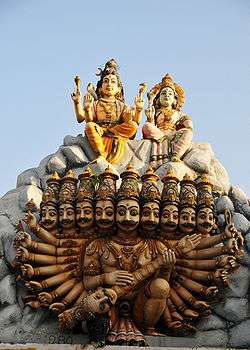
The word Rāvaṇa (Sanskrit: रावण) means roaring opposite of Vaiśravaṇa meaning "hear distinctly" (passive).[7][8] Both Ravana and Vaiśravaṇa, who is popularly known as Kubera, are considered to be patronymics derived as sons of Vishrava.[7][8][9][10]
"Rāvana" was a title taken on later by Dashananda, and it means in Sanskrit, "screamer." (Ravana would sing hymns).[11] Further, "roravana" is Sanskrit for "loud roaring."[12] In Abhinava Gupta's Krama Shaiva scripture, "yāsām rāvanam" is used as an expression to mean people who are truly aware in terms of the materialism of their environment.
According to F. E. Pargiter the word may originally have been a Sanskritisation of Iraivan, the Tamil name for a lord or king.[13]
Ravana has many other popular names such as Dasis Ravana, Dasis Sakvithi Maha Ravana, Dashaanan, Ravula, Lankeshwar, Lankeshwaran, Ravanasura, Ravanaeshwaran, Eela Vendhar.[14]
Iconography
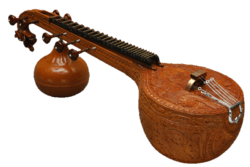
Ravana is depicted and described as having ten heads, although sometimes he is shown with only nine heads because he has sacrificed a head to convince Shiva. He is described as a devout follower of Shiva, a great scholar, a capable ruler and a maestro of the Veena. Ravana is also depicted as the author of the Ravana Samhita, a book on Hindu astrology and book Arka Prakasham; book on Siddha medicine and treatment . Ravana possessed a thorough knowledge of Siddha and political science. He is said to have possessed the nectar of immortality, which was stored inside his belly, thanks to a celestial boon by Brahma.[15]
Depiction in the Ramayana
Birth



Ravana was born to a great sage Vishrava (or Vesamuni), and his wife, the daitya princess Kaikeshi. People of Bisrakh village in Uttar Pradesh claim that Bisrakh was named after Vishrava, and Ravana was born there.[16]
Ravana's grandfather on his father's side, the sage Pulastya, was one of the ten Prajapatis or mind-born sons of Brahma and one of the Saptarishi (Seven Great Sages Rishi) in the first Manvantara. His grandfather on his mother's side, Sumali (or Sumalaya), king of the Raksasas, was the son of Sukesha. Sukesa's parents were King Vidyutkesa, who had married Salakantankata (daughter of Sandhya), who had abandoned Sukesha, but by the grace of Shiva he survived. Sumali had wished her to marry the most powerful being in the mortal world, so as to produce an exceptional heir. He rejected the kings of the world, as they were less powerful than him. Kaikesi searched among the sages and finally chose Vishrava, the father of Kubera. Ravana later usurped Lanka from his half-brother Kubera and became the King of Lanka. Rama had once addressed Ravana as a "Maha Brahman" ("Great Brahman" in the context of his education).
After worshiping Shiva on the banks of the Narmada, in the more central Yadu region, Ravana was captured and held under the control of king Kartavirya Arjuna, one of the greatest Yadu kings. It is clear from the references in the Ramayana that Ravana was no commoner among the Humans or Asuras, a great chanter of the Sama Veda.
Family
Ravana's family are hardly mentioned outside the Ramayana, which is viewed by some as being only the point of view of Rama devotees. According to that:
- Ravana's grandfather was Malyavan, who was against the war with Rama and laksman.
- Ravana's parents were Vishrava (son of Pulastya) and Kaikesi (daughter of Sumali and Thataka). Kaikesi had two brothers Maricha and Subahu which would effectively make them Ravana's uncles.
- Ravana had six brothers and two sisters:
- Kubera – the King of North direction and the Guardian of Heavenly Wealth. He was an older half-brother of Ravana: they were born to the same father by different mothers.
- Vibhishana – A follower of Rama and one of the most important characters in the Ramayana. As a minister and brother of Ravana, he spoke the truth without fear and advised Ravana to return the kidnapped Sita and uphold Dharma. Ravana not only rejected this sane advice, but also banished him from his kingdom. Vibhishana sought protection from Rama, which was granted without hesitation.
- Kumbhakarna – One of the most jovial demons in Hindu history. When offered a boon by Brahma, he was tricked into asking for eternal sleep. A horrified Ravana, out of brotherly love, persuaded Brahma to amend the boon. Brahma mitigated the power of the boon by making Kumbhakarna sleep for six months and being awake for rest six months of a year (in some versions, he is awake for one day out of the year). During the war with Rama, Kumbhakarna was untimely awakened from his sleep. He tried to persuade Ravana to open negotiations with Rama and return Sita to him. But he too failed to mend the ways of Ravana. However, bound by a brother's duty, he fought on the side of Ravana and was killed in the battlefield. Before dying he met Vibhishana and blessed him for following path of righteousness.
- Khara – King of Janasthan.[17] He protected the northern kingdom of Lanka in the mainland and his kingdom bordered with the Kosala Kingdom, the kingdom of Rama. He was well known for his superior skills in warfare.he was killed by Rama.
- Dushana – Viceroy of Janasthan.
- Ahiravan – King of the Underworld ruled by the rakshasas by Ravana and the demon king Maya.
- Kumbhini – Older sister of Ravana and the wife of the demon Madhu, King of Mathura, she was the mother of Lavanasura. She was renowned for her beauty and later retired to the sea for penance.
- Surpanakha – The sister of Ravana. She was the ultimate root of the kidnapping of Sita. She was the one who instigated her brothers to wage a war against Rama.
- Ravana was married to Mandodari, the daughter of the celestial architect Maya, Dhanyamalini, and a third wife. He had seven sons from his three wives:
- Meghnaad (also known as Indrajit because he defeated Indra), the most powerful son
- Atikaya
- Akshayakumara
- Devantaka
- Narantaka
- Trishira
- Prahastha
- In the Bengali ballad, Meghnad Bodh Kavya by Michael Madhusudan Dutt, Beerbahu is said to be Ravana's son.
Scholarly pursuits
Ravana was noted as a scholar and had knowledge of the Vedas. Even the Shaiva Nayanar saints wrote of him as such. Saint Jnana Sambandhar referred to him as, "versed in the Vedas and learning" and in the Tirumarais "Sama vedamore Githa mothia Dasamukan."
Ravana also was a musician and was specialized in both singing and the veena instrument. Saint Appar writes of Ravana in the Tirumarais that the king loved singing the Vedas, "Veda Githangal pada," "Kannalin githam pada," "patthu voi gitam pada," "thuttanai thuttu-thirthu-chuvai-pada-Githam ketta," and "Githakinnaram pada."
Tapasya to Brahma
Following his initial training, Ravana performed an intense penance (or tapasya) to Brahma, lasting several years. During his penance, Ravana chopped off his head ten times as a sacrifice to appease him. Each time he sliced his head off a new head arose, thus enabling him to continue his penance. At last, Brahma, pleased with his austerity, appeared after his tenth decapitation and offered him a boon. Ravana asked for immortality, which Brahma refused to give; in place of this, he asked for absolute invulnerability from and supremacy over gods, heavenly spirits, other rakshasas, serpents, and wild beasts. Contemptuous of mortal men, he did not ask for protection from these. Brahma granted him these boons in addition to his ten severed heads and great strength by way of knowledge of divine weapons and magic. Thus Ravana is also known as Dasamukha or Dashaanan (Dasa being ten, mukha/anan being face). Later, after learning from Ravana's mother (who can see fortune) Ravana's wife Mandodri brings him the nectar of immortality by suffering great hardships.
Devotee of Shiva
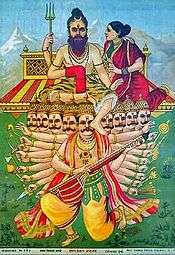
Following his conquest of Lanka, Ravana encountered Shiva at his abode in Kailash. Ravana at first went to meet Shiva. Nandi the vehicle of Shiva, refused to let Ravana in. He got annoyed and started teasing Nandi. Nandi in turn got annoyed and cursed Ravana that Lanka would be destroyed by a monkey. To show Nandi his love for Shiva, Ravana attempted to uproot and move the mountain on a whim. Shiva, annoyed by Ravana's arrogance, pressed his littlest toe on Kailash, pinning him firmly and painfully under it. His ganas informed Ravana of whom he had crossed, upon which Ravana became penitent. He plucked out his intestines and used them as strings to compose music and sang songs praising Shiva, and is said to have done so for years until Shiva released him from his bondage.
Pleased with his resilience and devotion, Shiva gave to him the divine sword Chandrahas (Chandra-Moon, Has-laugh, literally 'the laughter of the moon' but referring to the shape formed by a crescent moon which resembles a smile). It was during this incident that he acquired the name 'Ravana', meaning "(He) Of the terrifying roar", given to him by Shiva – the earth is said to have quaked at Ravana's cry of pain when the mountain was pinned on him. Ravana in turn became a lifelong devotee of Shiva and is said to have composed the hymn known as Shiva Tandava Stotra.
Shiva had given his sword Chandrahasa with a warning that if it was used for unjust causes, it would return to the three-eyed one and Ravana's days would be numbered.[18] After Ravana had been given the Celestial Nectar of Immortality by Brahma, he went on to please Shiva. He cut his head & put it as sacrifice for pleasing Shiva, but Shiva replaced his head with a new one. This was repeated Nine times, on which Shiva was happy and pleased with Ravana's resilience and devotion.
The devotion to Shiva by Ravana was written about by the Nayanar saints also. "Tham-aratthal pora-thankai kol val padai, Kamarathal Sivan Karatthu Vanginan." It is said that before he aimed him missile, he worshiped Isa (Shiva) in his usual manner and performed puja, "Pusanai-tholil - purinthu-than-Muraimayir-potrum-Isanai-tholuthu." By his austerities and penances for years he obtained boons from Shiva, as longevity, and a broad bright sword, which gave him victory over battles; "mukkodi vannal," "valodu nal avarkku arul seitha." It is believed by some that he made a six-stringed yal instrument, and it was his forte. With it made of his own nerves, he pleased Shiva and won His mercy and grace; "Tham-aratthal pora-thankai kol val padai, Kamarathal Sivan Karatthu Vanginan."
Priestly ministers
Ravana is said in some version to have had Shukra Acharya, the priest of the Asuras, as his minister, and in some versions Brihaspati, the priest of the Devas.
One of the most original, which is not found in earlier manuscripts, tells how Ravana orders his court priest Brhaspati (all the gods are his slaves) to read the Chandi stava (mantras of Chandi), that is, the Devi Mahatmya, in order to stave off defeat; if he can recite it. According to the Krttivasa text, Ravana arranged for a peaceful yajna (sacrifice) and to start the recitation of Chandi, Brhaspati was invited. Accordingly, Brhaspati recited the same correctly.[19]
King of Lanka
After winning these boons, Ravana sought out his grandfather, Sumali, and assumed leadership over his army. He then set his sights on capturing the island city of Lanka.
Lanka was an idyllic city, created by the celestial architect Vishwakarma for Shiva and acquired by Kubera, the treasurer of the gods upon advice of his father Visravas. Visrava had asked for Lanka made from gold from Shiva as dakshina for the house warming ceremony he had conducted for Lanka. Kubera had generously shared all that he owned with Ravana and the latter's siblings, who were Kubera's half-brothers and half-sister from his stepmother Kaikesi. However, Ravana demanded Lanka wholly from him, threatening to take it by force. Vishrava, their father, advised Kubera to give it up to him, as Ravana was now undefeatable.
Although Ravana usurped Lanka, he was nevertheless regarded as a benevolent and effective ruler. Lanka flourished under his rule, to the extent that it is said the poorest of houses had vessels of gold to eat and drink off, and hunger was unknown in the kingdom.
Emperor of the Three Worlds
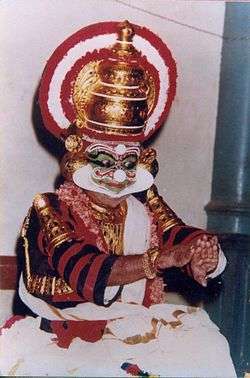
His abilities now truly awe-inspiring, Ravana proceeded on a series of campaigns, conquering humans, celestials and other demons. Conquering the netherworld completely, he left his brother Ahiravana as king. He became supreme overlord of all Asuras in the three worlds, making an alliance with the Nivatakavachas and Kalakeyas, two clans he was unable to subdue. Conquering several kingdoms of the human world, he performed the suitable sacrifices and was crowned Emperor. Ravana defeated Indra and the gods, Surya, Varuna and Yama.
Kubera at one point chastised Ravana for his cruelty and greed, greatly angering him. Proceeding to the heavens, Ravana fought and defeated the Devas, singling out his brother for particular humiliation. By force he gained command over the Devas, celestials, and the serpent races. At the time of the Ramayana, set several years later, Ravana is shown as dominating all human and divine races – so much so that he can command the sun's rising and setting.
Depiction in other Scriptures
As Vishnu's cursed doorkeeper
In the Bhagavata Purana, Ravana and his brother, Kumbhakarna, were said to be reincarnations of Jaya and Vijaya, gatekeepers at Vaikuntha, the abode of Vishnu and were cursed to be born in Earth for their insolence.
These gatekeepers refused entry to the Sanatha Kumara monks, who, because of their powers and austerity appeared as young children. For their insolence, the monks cursed them to be expelled from Vaikuntha and to be born on Earth.
Vishnu agreed that they should be punished. They were given two choices, that they could be born seven times as normal mortals and devotees of Vishnu, or three times as powerful and strong people, but as enemies of Vishnu. Eager to be back with the Lord, they choose the latter one. Ravana and his brother Kumbhakarna were born to fulfill the curse on the second birth as enemies of Vishnu in the Treta Yuga. The curse of first birth was fulfilled by Hiranyakashipu and his brother Hiranyaksha in Satya Yuga when they were both vanquished by earlier avatars of Vishnu (Hiranyaksha by Varaha and Hiranyakashipu by Narasimha) and the curse of third birth was fulfilled by Dantavakra and Shishupala in the Dwapar Yuga when they both were slain by Krishna, the eighth avatar.
Conflict with other kings and Asuras
Ravana had gotten into a conflict with some other major Asuras.
In Maheshwar, Madhya Pradesh is where he is said to have fought, but lost, to Kartavirya Arjuna, and he was tied up. He vanquished
- Marutta (Chakravarti King of Ushiraviga),
- Gadhi (Vishwamitra's father),
- Dushyanta (Bharata's father),
- Suratha (King of Vidarbha),
- Gaya (Chakravarti king of Dharmaranya), and
- Paurava (King of Anga).
- Ravana killed Anaranya, the king of Ayodhya although the latter cursed Ravana to be slain by Rama. Ravana was vanquished by the Ikshvaku King Mandhata, an ancestor of Rama.
Ravana had wrestled his brother Kubera for the Puspaka car.
In the Ramayana, he had fought Bali the Kishkindha King, but was defeated by him.
He had also fought with the Nivatakavachas, the descendants of Prahlada, but being unable to defeat them, struck an alliance with them.
Another time he was vanquished by the sage Kapila. One time, upon hearing a discourse from Sage Sanatkumara, Ravana attempted to invade Vaikuntha. Only Ravana managed to enter Vaikuntha's capital Shwetadwipa where he was hopelessly outmatched by the inhabitants over there and was forced to retreat.
Ravana as a Scholar
Many legends celebrate Ravana as an accomplished king and erudite scholar. As a child, he studied the Vedas and the Vedangas from his father, Sage Vishrava. He studied statecraft under none other than Bhrigu's son Shukracharya himself. Ravana was a skilled Veena player having built the Rudra Veena from his head, arms and nerves. He was also learned in the intricacies of the Sanskrit language and extemporaneously composed the Shiva Tandava Stotram despite being under excruciating pain under the Kailash Mountain. Ravana was learned in astrology and Ayurveda as well.
Historicity
According to the Uttra Kanda section of Ramayana, the Rakshasa were the demons or evil people[21] in Sri Lanka. They were led by Malyavantha, Sumali and Sukesha of the Rakshasa, who were ousted by the Deva with the help of Vishnu, and then subsequently ruled by King Ravana.[22]
There have been several Buddhist Ramayanas written, and in the Dasaratha Jataka, the Buddha is said to have been Rama in a previous life.[23] Furthermore, even today Vibhishana (the brother of Ravana) is one of the compatriots of the Sri Lankans held in high esteems as a national hero. In the Ramayana, Vibhishana had defected from Ravana's administration to help Rama overthrow the tyrant demon Ravana. Ever since then, Vibhishana has been venerated as one of the four guardians (another being Vishnu) of Sri Lanka.[24]
Buddhist scriptures mention rakshasas, a general term for evil people, including ones in Sri Lanka. In one story, because the island has a huge problem with cannibal rakshasas, the hero Simhala escaped to later return and rid Sri Lanka of the plague of cannibalism.[25] Further, the Buddhist scripture Janavamsa of 15th century Sri Lanka mentions cannibalism on the island.[26]
Modern descendants of Ravana
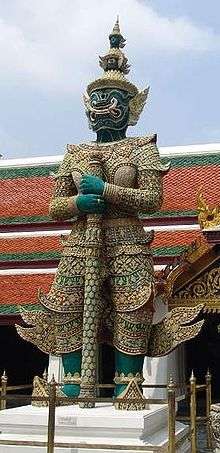
There are some Shaiva temples where Ravana is worshiped.[27][28][29] Ravana is considered most revered devotee of Shiva. The images of Ravana are seen associated with Shiva at some places.
Just as there are Brahmins whose origins are associated with Rama, such as the Saryuparins that came into being when Rama reached Ayodhya after slaying Ravana, and the Sanadhs, who recall their acceptance of dakshina from Ramchandra on the victory over Ravana, there are also Brahmins that are associated in origin from Ravana, and these include the Daves (of Mudgal gotra) of Rajasthan, as well as Gujarat's Sachoras, the Kanyakubjas of Vidisha in Madhya Pradesh, and the Brahmins of the Kaumara sub-gotra of the Vasistha gotra. Ravana himself is described in some Ramayanas to have been as Brahmin because he was the son of Rishi Vishrava and grandson of Pulastya. The Indonesian Ramabatara also described Ravana as having been a Brahmin.[30] Ravana described himself to Sita as being of Kashyapa lineage.
The Dave Brahmins of Mudgal gotra and the Shrimali Brahmins, in Jodhpur/Mandor of Rajasthan state who were originally from Gujarat, India claim to be the descendants of Ravana. The say that since time immemorial they are performing the shraddha (death anniversary) of Ravana on Dashehra Day every year. They offer pind daan and take a bath after that ritual. They recently erected a Ravan temple in Jodhpur, India where daily puja is performed.
The Kanyakubja Brahmins of Vidisha district worship Ravana as he is personified as a symbol of prosperity and regarded as a saviour by them, and they claim that Ravana was also a Kanyakubja Brahmin. Thousands of Kanyakubja Brahmins of the village Ravangram of Netaran, in the Vidisha District of Madhya Pradesh, perform daily puja (worship) in the Ravan temple and offer naivedyam / bhog (a ritual of sacrifice to the Gods). Centuries ago King Shiv Shankar built a Ravana temple at Kanpur, Uttar Pradesh. The Ravana temple is opened once in a year, on Dashehra Day, to perform puja for the welfare of Ravana.[31]
The Sachora Brahmins of Gujarat also claim to descend from Ravana, and have "Ravan" as their surnames sometimes.[32]
A Brahmin gotra descending from Rishi Kaumarayana, which is a sub-section of the Vasistha gotra is identified in lineage from Ravana ("kaumarah ravanah koksah krsnah.")[33]
Saraswat Brahmins from Mathura also claim to descend from Ravana. One lawyer from Mathura, Omveer Saraswat, had written to politicians to ban Ravan Dahan.[34][35]
There is also reference to "Ravani", lineage of Upadhyaya Yasastrata II, who was of the Gautama gotra and was a son of Acharya Vasudatta, and described as "born of Ravani" [36]
In the Valmiki Ramayana,[37] Ravana mentions himself to be of the Kashyapa gotra, and the Lankavatara Sutra says Ravana is a worshiper of Kashyapa Buddha (a Brahmin.)
The Gondi people of central India claim to be descendants of Ravana, and they also have temples set up for him, his wife Mandodari, and their son Meghnad. They also state that Ravana was ancient Gond king, and the tenth dharmaguru of their tribe. Every year on Dussehra, the Gondis of the village of Paraswadi carry an image of Ravana riding on an elephant in a procession.[38][39]
Temples built by Ravana
In Himachal Pradesh
Baijnath Temple was a Shaiva temple in Himachal Pradesh state, also known as Ravankhola (Place of Ravana).
Many people believe that Baijnath is not where Ravana descended to the earth, and that either the Baidyanath Temple in Jharkhand state or Vajinath in Maharashtra state is the actual site.
In Chandigarh
During Dussehra before the effigy of Ravana is set ablaze, participants offer prayers to the king, because "His father was a Brahman and people worship him for his intelligence and knowledge."
In Gujarat
Somanath - The second version of the Shaiva temple in Gujarat state is said by tradition to have been renovated by Ravana.[40]
In Maharashtra
Two Hemadpanti temples were built by Ravana's demons in Kuntalapur within Maharashtra state.
In Karnataka
Mahabaleshwar is a Shaiva temple in Gokarna, Karnataka is also said by tradition to have been built by Ravana.[41]
Murudeshwara is a Shaiva temple in Karnataka state is said by tradition to have been built by Ravana. It lies in the holy beach town in the Bhatkal Taluk of Uttara Kannada district of Karnataka state.[41]
Dharashwara is a Shaiva temple in Karnataka is said by tradition to have been built by Ravana.[41]
Gunavanteshwar is a Shaiva temple in Karnataka is said by tradition to have been built by Ravana.[41]
Shejjeshwar is a Shaiva temple in Karnataka is said by tradition to have been built by Ravana.[41]
In Andhra Pradesh
Kakinada is a Shaiva temple in Andhra Pradesh containing a huge Shivalinga, supposedly installed by Ravana himself, with a statue of Ravana near by. Both Shivalinga and Ravana are worshiped by the fishermen community there.
Other temples and relevant places
In Uttar Pradesh
At the Vrihadeshwar Mahadev Temple by the Yamuna River, Saraswat Brahmins, of the region claiming to descend from Ravan, worship the king.
In Madhya Pradesh
Ravana is said to have married Princess Mandodari at a place Mandsaur in Madhya Pradesh, India. This is so because in Mandsaur, Ravana is worshiped.
At the altar can also be found the images of Saptamatri (Seven Mothers) flanked by Ganesha and Veerabhadra. The Saptamatri images are said to precede the time of the Pratihara Dynasty (founded in the 6th century AD) and are in fact reminiscent of the images of seven female deities of Harappa – the oldest civilisation in India. In the nearby stepwell, a stone bears a script that resembles the Harappan script.
In Sri Lanka
Koneswaram temple, then-Dakshina Kailasam is a classical-medieval Hindu temple complex in Trincomalee, a Hindu religious pilgrimage centre in Eastern Province, Sri Lanka. This temples is associated with Ravana and his mother. They had worshiped Shiva at the shrine.
Kanniya Hot water spring in Sri Lanka has the history from the King Ravana era. It says that King Ravana stuck the earth with his sword in several spots for his mother's funeral event and several fountains were started on those places. The water was hot and it is now a tourist attraction in Sri Lanka.
Ravana-Dahan (burning effigy of Ravana)

Effigies of Ravana are burned on Vijayadashami, in India at many places. It is said that it is symbolisation of triumph over evil (i.e. Ravana) by Rama.
Ravanahatha
The ancient instrument known as a Ravanahatha is said to have belonged to a sovereign in present-day India around 5000 BC. It replicates the ancient instrument called Ravan Hatta which is found even today in Rajasthan. Mythology credits this creation to Ravana.
The Ravanahatha was played on one string which was 22 inches long encompassing the 3 Octaves. Whereas the Violin encompasses the 3 octaves on 4 strings with a finger board which is 5 1/4 inches long.This 5 1/4 when multiplied by 4 is 21 inches which was the size of the Ravan Hatta. Both are played with a bow.[42]
Influence on Indian culture and art
A Ramleela actor wears the traditional attire of Ravana. One of the most important literary works of ancient India, the Ramayana has had a profound impact on art and culture in the Indian subcontinent and Southeast Asia.
Texts attributed to Ravana
Astronomy
There is also texts attributed to Ravana. The Ravan Samhita is an astrological text or scripture narrated by Shiva and written by Ravana.
Medicine
The Ravanakumara Tantra is a part of the tantric rituals of the Kriyakalagunottara Tantra,[43] and it is an 11th-century Sanskrit work for the treatment of children's diseases.[44] It is also known as the Ravanaproktabalacikitsasutra ("Sutra Spoken by Ravana on the Curing of Children's Diseases.")
Ravana appears as the composer of the 16th century C.E. text, Arka Prakasa, which is a dialogue between the king of Lanka and his wife Mandodhari about which herbs and chemicals can be used in a mixture to cure illnesses, such as syphilis
Ravana is also the composer of the 16th century C.E. scriptures Nadi Pariksa and Nadi Vijnana on knowledge about the veins.
Linguistics
Ravana is the composer of the Ravanabhet, a Vedic text on phonetics of the Sanskrit language.
Ravana is also the composer of the Ravaniya, also known as Ravanabaith, text on phonetics of the Telugu language.
"Ravana Lankesvara" is to whom the Prakrta-Kamadhenu grammatical text on the Prakrit language is attributed.
Spirituality
There is also the Samkhya scripture known as the Ravana-bhasya, which is also known as Ravanabhasya, is believed to be written by Ravana.
The writer of the Vaisesika scripture Katandi (commentary on the Vaisesika Sutra) is attributed to have been written by Ravana.
Ravana is also the name used by a commentator of the Shaiva Rudrapurascharana.
"Ravanacharya" is the scholar who wrote the Padaratna, a commentary on the Rig Veda.
Ravana is the composer of the Shavite scripture, Shiva Tandava Stotram.
Alternate Ramayanas
Buddhist versions
Rama is always the protagonist. In Rin-spuns-pa Tibetan Ramayana, it is prophesied that "Ramana" will return as the Buddha incarnation of Vishnu in the Kali Yuga.
The Khamti Ramayana as well describes Rama as a Bodhisattva incarnated to punish demon Ravana.
In the Laotian Buddhist text, Phra Lak Phra Lam, Rama is a Bodhisattva and the embodiment of virtues, while Ravana is a Brahmin ("mahabrahma") son of Virulaha but is highly materialistic.
In the Cambodian Buddhist text, Preah Ream, Buddha is an incarnation of Rama and Ravana is a rakshasa.
In the Thai Buddhist text, Ramakien, Ravana is a rakshasa.[45] There, he is instead known as "Thotsakan" (ทศกัณฐ์, from Sanskrit दशकण्ठ, Daśakaṇṭha, "ten necks"), and he is depicted with green skin.
In the Lankavatara Sutra, Gautama Buddha pays a visit to Ravana in the demon's layer in Lanka, and in the scripture he is addressed as a "Rakshasas." He is normally identified as a demon.
In the Karandavyuha Sutra, god Yama asks if the visitor in hell (Avalokitesvara) that he hasn't seen yet is a god or a demon, and asks whether he is Vishnu, Mahesvara, or the "rakshasa" ("demon") Ravana.
Jain version
Jain accounts vary from the traditional Hindu accounts of Ramayana. The incidents are placed at the time of the 20th Tirthankara, Munisuvrata. According to Jain version, both Rama as well as Ravana were devout Jains.[46] Ravana was a Vidyadhara King having magical powers.[47] Also, as per the Jain accounts, Ravana was killed by Lakshmana and not Rama in the end.[48]
See also
References
Notes
Citations
- ↑ "Ravana". Random House Webster's Unabridged Dictionary.
- ↑ Mani, Vettam (1975). Puranic Encyclopaedia: A Comprehensive Dictionary With Special Reference to the Epic and Puranic Literature. Delhi: Motilal Banarsidass. p. 354. ISBN 978-0-8426-0822-0.
- ↑ Merriam-Webster's Encyclopedia of World Religions. Merriam-Webster. 1999. p. 909. ISBN 9780877790440.
- ↑ "Only the elderly come to mourn Ravana in 'birthplace' Bisrakh". The Indian Express. 2014-10-04. Retrieved 2016-06-14.
- ↑ "Ravana in Noida: A book on Greater Noida". http://www.hindustantimes.com/. 2014-03-15. Retrieved 2016-06-14. External link in
|website=(help) - ↑ "Bisrakh seeks funds for Ravan temple - Times of India". The Times of India. Retrieved 2016-06-14.
- 1 2 Aiyangar Narayan (1909) "Essays On Indo-Aryan Mythology-Vol.", p.413
- 1 2 MW Sanskrit Digital Dictionary p. 1026
- ↑ The Ramayana Of Valmiki (Vol.2) Ayodhyakanda An Epic Of Ancient India
- ↑ Hopkins, Edward Washburn (1915). Epic mythology. Strassburg K.J. Trübner. p. 142.
- ↑ Ramayana By William Buck, Barend A. van Nooten, Shirley Triest
- ↑ [Meaning of "roravana" at Sanskrit Dictionary http://www.spokensanskrit.de/index.php?tinput=roravaNa&script=&direction=SE&link=yes]
- ↑ Roy, Janmajit (2002). Theory of Avatāra and Divinity of Chaitanya. ISBN 9788126901692.
- ↑ "Early Tamils of Ilangai". Scribd. Retrieved 2016-04-04.
- ↑ Ramayana By Valmiki; Ramcharitmas by Tulsidasa (Lanka Kanda Vibhishana & Rama Samvaad)
- ↑ IBNLive. "CNN-IBN News: Breaking News India, Latest News, Current Headlines World - IBNLive". IBNLive.com.
- ↑ "History Hindus". Archived from the original on 2011-08-09.
- ↑ Gopal, Madan (1990). K.S. Gautam, ed. India through the ages. Publication Division, Ministry of Information and Broadcasting, Government of India. p. 81.
- ↑ Genesis and Evolution of the Rāma Kathā in Indian Art, Thought, Literature, and Culture: From the Earliest Period to the Modern Times, Volume 2 By Shanti Lal Nagar
- ↑ Māni Mādhava Chākyār (1996). Nātyakalpadrumam. Sangeet Natak Akademi, New Delhi. p. 6.
- ↑ Sanskrit Dictionary
- ↑ Ramayana Research. (2008). A Short History OF Heladiva. Available: http://ramayanaresearch.com/heladiva.html. Last accessed 14 March 2010.
- ↑ P. 457 Early Interactions Between South and Southeast Asia: Reflections on Cross-Cultural Exchange. edited by Pierre-Yves Manguin, A. Mani, Geoff Wade
- ↑ Lanka Library
- ↑ P. 411 Buddhism in Practice: (Abridged Edition) By Donald S. Lopez Jr.
- ↑ P. 38 Vegetarianism and Animal Ethics in Contemporary Buddhism By James Stewart
- ↑ Ravana has his temples, too. The Sunday Tribune – Spectrum. 21 October 2007.
- ↑ Vachaspati.S, Ravana Brahma [in English], 2005, Rudrakavi Sahitya Peetham, Gandhi Nagar, Tenali, India.
- ↑ Kamalesh Kumar Dave,Dashanan [in Hindi], 2008, Akshaya Jyotish Anusandan Kendra, Quila Road, Jodhpur, India.
- ↑ P. 20 Literature and Social Life in Mediaeval Orissa By Krishna Charan Sahoo
- ↑ Siddiqui, Faiz (10 October 2016). "A temple where demon king has his day". The Times of India. Retrieved 14 September 2018.
- ↑ People of India: A - G., Volume 4. Oxford Univ. Press. p. 3061.
- ↑ "kaumarah ravanah koksah krsnah" from P. 183 The Early Brahmanical System of Gotra and Pravara By Puruṣottama Paṇḍita
- ↑ "Mathura lawyer seeks ban on burning of Ravana effigies"
- ↑ "A Dussehra without burning Ravana: This Brahmin community in Agra wants an end to practice"
- ↑ Indian Culture: Journal of the Indian Research Institute, Volume 15 By I.B. Corporation
- ↑ "I am of the Kashyapa gotra am deeply versed in the Vedas and all their branches. I have studied the dharmashastra of Manu, yoga of Maheshwara, political treatise of Brihaspati, logic of Medhatithi, and rules for after-death rituals laid down by Prachetas."
- ↑ Asuras? No, Just Indians, Outlook India
- ↑ Celebrating Ravan, The Hindu
- ↑ P. 77 Gazetteer of the Bombay Presidency ..., Volume 15, Part 2
- 1 2 3 4 5 Gazetteer of the Bombay Presidency Volume 15, Part 2: Kanara. Government Central Press. 1883.
- ↑ "Ranjan Violin". tripod.com.
- ↑ The Alchemical Body: Siddha Traditions in Medieval India By David Gordon White
- ↑ P. 21 The Quarterly Review of Historical Studies, Volumes 41-43 By Institute of Historical Studies
- ↑ Vyas, Lallan Prasad. Prachi Darshan. p. 98.
- ↑ Sharma, S.R. (1940), Jainism and Karnataka Culture, Dharwar: Karnatak Historical Research Society, p. 76
- ↑ Dalal, Roshen (2010), Hinduism: An Alphabetical Guide, India: Penguin Books, p. 338, ISBN 9780143414216
- ↑ Ramanujan, A.K. (1991), "Three hundred Rāmāyaṇas: Five examples and Three thoughts on Translation", in Paula Richman, Many Rāmāyaṇas: The Diversity of a Narrative Tradition in South Asia, University of California Press, p. 35, ISBN 978-0-520-07589-4
Bibliography
- Doniger, Wendy (1993), Purana Perennis: Reciprocity and Transformation in Hindu and Jaina Texts, SUNY Press, ISBN 9780791413814
- Udayakumar, S.P. (2005). "Presenting the Past: Anxious History and Ancient Future in Hindutva India". Greenwood Publishing Group
External links
| Wikimedia Commons has media related to Ravana. |
| Preceded by Kubera |
Emperor of Lanka | Succeeded by Vibhisana |

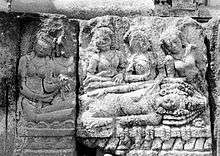
.jpg)